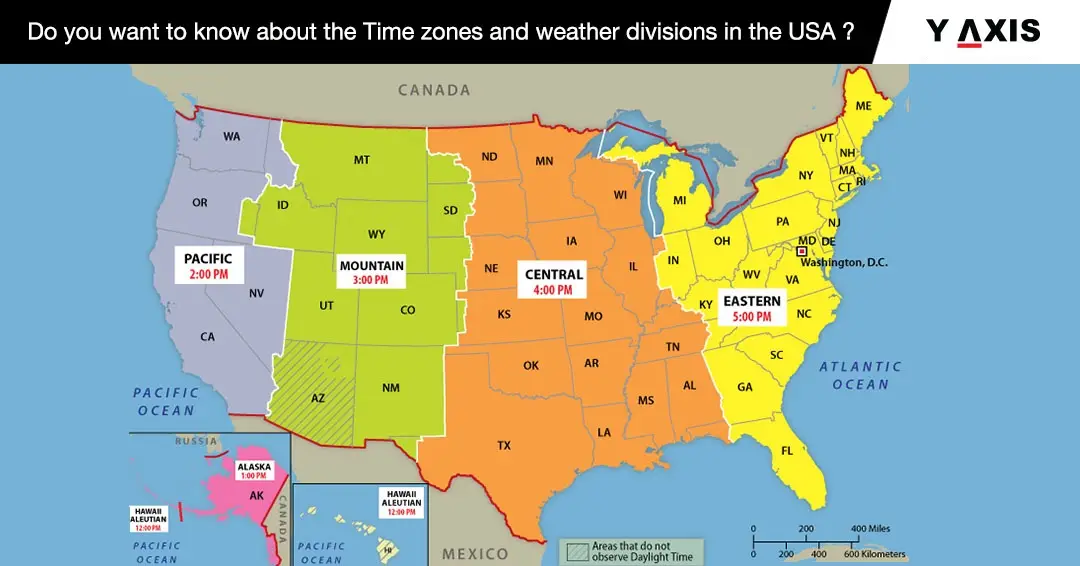Posted on September 27 2023
Time Zones and Weather Divisions in USA
By , Editor
Updated September 16 2024
Time Zones
A time zone is one among the 24 spherical lunes, which is a section on the globe in a north/south direction having equal width, each assigned with one of the 24 hours.
Every section observes a uniform standard time to keep track of the day and night cycle. It means that in each geographic region within a time zone, people use the same time.
All these zones are defined by the Coordinated Universal Time (UTC) by a number of hours centered on the prime meridian.
The U.S. Time Zones
The below map depicts the six time zones of the United States and the actual time in the different time zones.
It is given from West to East:
- Hawaii-Aleutian Time (HAT)
Hawaii-Aleutian Standard Time – HAST (UTC-10)
Hawaii-Aleutian Daylight Time – HADT (UTC-9)
- Alaska Time (AST)
Alaska Standard Time – AKST (UTC-9)
Alaska Daylight Time – AKDT (UTC-8)
- Pacific Time (PT)
Pacific Standard Time – PST (UTC-8)
Pacific Daylight Time – PDT (UTC-7)
- Mountain Time (MT)
Mountain Standard Time – MST (UTC-7)
Mountain Daylight Time – MDT (UTC-6)
- Central Time (CT)
Central Standard Time – CST (UTC-6)
Central Daylight Time – CDT (UTC-5)
- Eastern Time (ET)
Eastern Standard Time – EST (UTC-5)
Eastern Daylight Time – EDT (UTC-4)
|
Time Zone |
Abbreviation |
States |
GMT = 12.00 pm |
|
Eastern Standard Time |
EST |
Connecticut, Delaware Georgia, Maine, Maryland, Massachusetts, Michigan, New Hampshire, New Jersey, New York, North Carolina, Ohio, Pennsylvania, Rhode Island, South Carolina, Vermont, Virginia, Washington DC, West Virginia |
7:00 AM |
|
Central Standard Time |
CST |
Alabama, Arkansas, Illinois, Iowa, Louisiana, Michigan (Upper Peninsula), Minnesota, Mississippi, Missouri, Nebraska, Oklahoma, Wisconsin |
6:00 AM |
|
Mountain Standard Time |
MST |
Arizona, Colorado, Montana, New Mexico, Utah, Wyoming |
5:00 AM |
|
Pacific Standard Time |
PST |
California, Nevada, Washington |
4:00 AM |
|
Alaska Standard Time |
AKST |
Main part of Alaska (Anchorage, Juneau, Nome) |
3:00 AM |
|
Yukon Standard Time |
YST |
||
|
Alaska-Hawaii Standard Time |
AHST |
Aleutian islands (west of Alaska), Hawaii |
2:00 AM |
While the below states lie in two time zones:
|
Time Zone |
States |
|
Eastern Standard Time and Central Standard Time |
Florida, Indiana, Kentucky, Tennessee |
|
Central Standard Time and Mountain Standard Time |
Kansas, Nebraska, North Dakota, South Dakota, Texas |
|
Mountain Standard Time and Pacific Standard Time |
Idaho, Oregon |
The U.S. Weather Divisions
In the U.S., there are 344 climate divisions that are based on the CONUS (Continental US). For every climatic division, monthly station temperature and precipitation values are computed from the daily observations.
The divisional values are weighted by area to compute state-wide values, and the state-wide values are weighted by area to compute regional values.
The U.S. is typically grouped into five regions: The Northeast, the Southwest, the West, the Southeast, and the Midwest. USA climate varies dramatically by region.
The area could be split even further into three types of climate: coastal Mediterranean climates, Desert climates, and Mountainous alpine climates. In all three of these areas, summers are hot and dry.
There Are 4 Major Climate Zones:
- Tropical zone from 0°–23.5° (between the tropics)
- Subtropics from 23.5°–40°
- Temperate zone from 40°–60°
- Cold zone from 60°–90°
The Six Major Climate Regions Are Polar, Temperate, Arid, Tropical, Mediterranean and Tundra.
- Polar Chill. Polar climates are very cold and dry throughout the year. …
- Temperate Regions
- Arid Zones
- Damp Tropical Regions
- The Mild Mediterranean
- The Cold Tundra
Some people prefer to have all four seasons – fall, winter, spring and summer – and all of the weather that comes with each.
List of States in the U.S. With the Best Weather Conditions:
- California
- Hawaii
- Texas
- Arizona
- Florida
- Georgia
- South Carolina
- Delaware
- North Carolina
- Louisiana
What is a time zone?A time zone is an area wherein a common standard time is applicable, for economic, legal, and social reasons. |
How many time zones are there in the US?There are six time zones in the US main country. The 50 US states are spread across the six standard time zones. With dependencies (inhabited and uninhabited), however, the total count comes to 11 time zones. |
What are the six time zones in the US states?The six time zones within the 50 US states are – Alaska time, Central time, Eastern time, Hawaii-Aleutian time, Mountain time, and Pacific time. |
Which US states have more than one time zone?15 US states have more than one time zone. These are – Florida, Oregon, Kentucky, Arizona, Texas, Tennessee, North Dakota, Michigan, Alaska, South Dakota, Nevada, Kansas, Nebraska, Idaho, and Indiana. |
Tags:
Time Zones
Work in USA
Share
Options for you by Y-Axis
Get it on your mobile
Get News alerts
Contact Y-Axis

